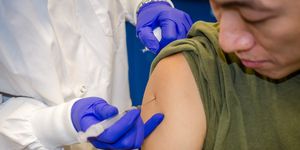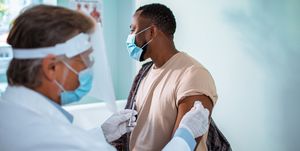All the COVID-19 Vaccine Side Effects, Explained

With the Pfizer BioNTech BNT162b2 vaccine and Moderna’s mRNA-1273 vaccine currently being administered to select groups, the buzz around the COVID-19 vaccine is palpable. Public response to the idea of a vaccine has also grown more favorable, with a national survey from PEW Research Center indicating that 60 percent of Americans would definitely or probably get a vaccine for the coronavirus, up from 51 percent in September.
Yet among many people who are in line to get the vaccine, those who aren’t yet eligible, and those who are hesitant, there are questions about exactly what the side effects of those vaccines are, and how often they occur.
Collectively, the companies’ clinical trials have tested more than 73,000 people and separately have produced vaccines with over 90 percent effectiveness. The vaccines teach your body to produce an immune response, and they do have the potential for short-term side effects.
What are the side effects and how often do they occur?
Natasha Bhuyan, MD, a practicing family physician based in Phoenix, AZ, says side effects from the COVID-19 vaccine were expected and they are short-lived (think a day or so).
“It is entirely normal to experience some side effects with any vaccination: arm soreness, fatigue, body aches, and even fever,” explains Jay W. Lee, MD, MPH, a practicing family physician based in Orange County, CA.
Side effects seen in the Moderna vaccine trials
The company reported that during its Phase 3 trials it saw:
Side effects seen in the Pfizer vaccine trials
Pfizer reported that during its Phase 3 trials, it saw:
While the Pfizer report above focused on events that produced severe reactions greater than 2 percent of the time, the CDC reports that other side effects include:
There were also four reported cases of Bell’s palsy, which is the sudden weakness in facial muscles (think facial paralysis) on one side of the face, in each company’s trial.
A lot of these side effects aren’t really all that out of the ordinary. The seasonal flu shot, which injects the inactive virus into you to help boost immunity, for example, also has side effects, which, according to the Centers for Disease and Prevention (CDC) include soreness, redness, and/or swelling from the shot, headache, fever, nausea, muscle aches—many of which are similar to what participants in COVID-19 trials have experienced.
When these side effects occur, how long do they last?
For those who experience side effects, they don’t last very long— about 48 hours.
For both vaccines, the side effects are most prominent after the booster shot. In an interview with CNN’s Anderson Cooper, one woman who was a part of the Moderna vaccine trials noted having little effect from the first vaccine, but experienced more severe symptoms (muscle, joint and bone pain), lasting for about four hours, after the booster shot.
Again, most of these reactions are normal. They mean the vaccine is doing its job, creating antibodies that will not only help your body build protection against the disease (get the full story on how they work here), but train it to fight diseases much faster. Interestingly, though, younger adults reported experiencing side effects more than older adults.
What about the allergic reactions we’ve heard about?
Trials aside, the administration of the Pfizer vaccine to health care workers have seen allergic reactions for some, including three Alaskans. One had an anaphylactic reaction—a severe, potentially life-threatening allergic reaction—that included a rash on her face and torso, shortness of breath and an elevated heart rate and resulted in her being admitted to the ICU.
Another experienced eye puffiness, lightheadedness, and a scratchy throat, but after being treated with epinephrine, returned to normal. Both healthcare workers experienced these symptoms 10 minutes after receiving their shot.
The last also had symptoms of an allergic reaction, which consisted of difficulty breathing, swelling of the tongue, and a hoarse voice. All three healthcare workers experienced these symptoms about 10 minutes after receiving their shot. (Three British health care workers with a history of allergies who received the vaccine also developed anaphylactic symptoms.)
Who, with allergies, should ask their doctor before getting the vaccine
The recent reactions have now prompted the CDC to include language on its website about the potential for anaphylaxis as well the recommendation that folks with a history of it, regardless of the cause, be observed for 30 minutes post vaccine administration. (Everyone else should be observed for 15 minutes.) And per an FDA fact sheet, if a severe allergic reaction were to occur, signs would likely surface between minutes and an hour post vaccination.
What was discovered about allergies during the trials
It should be noted that a document published by the FDA prior to Pfizer’s EUA did highlight that 0.63 percent of participants experienced “hypersensitivity-related adverse events.” A similar document released by the FDA prior to Moderna’s EUA revealed that 1.5 percent of participants also experienced hypersensitivity, though “there were no anaphylactic or severe hypersensitivity reactions.” In other words, the potential for allergic reactions was always there. Though, specifically in Pfizer’s trials, it is reported that folks with a history of severe reaction to any vaccine as well as a severe allergic reaction to any part of the study interventions were not included.
What might be causing the allergic reactions
There are some reports that at a recent briefing, Peter Marks, MD, PhD, the director of the Center for Biologics Evaluation and Research (CBER) at the FDA speculated that there might be a link between allergic reactions and polyethylene glycol (PEG), which is a component, though in different forms, in both Pfizer’s and Moderna’s vaccines.
Also noteworthy: In an alleged email dated September 25 from Robert F. Kennedy, Jr. and Children’s Health Defense to FDA Director Steven Hahn, MD, Marks and National Institute of Allergy and Infectious Diseases Director Anthony Fauci, MD as well as several senators and people in Congress concerning Moderna’s COVID-19 vaccine, Kennedy wrote: “The use of PEG in drugs and vaccines is increasingly controversial due to well-documented incidence of adverse PEG-related immune reactions, including life-threatening anaphylaxis.” He went on to write that “roughly seven to ten Americans may already be sensitized to PEG, which may result in reduced efficacy of the vaccine and an increase in adverse side effects.”
According to Purvi Parikh, MD, an allergist and immunologist at NYU Langone, who is also a co-investigator on COVID vaccine trials, “allergic reactions are quite rare” in vaccines in general, pointing to a review study in the Journal of Clinical Allergy and Immunology which found that the rate of anaphylaxis was 1.31 per million vaccine doses. “Also, usually people are allergic to an ingredient rather than vaccine itself,” she says, noting that new CDC recommendations cite that if there’s a reaction, you should not take the second dose, and you should see an allergist for evaluation.
It’s possible that the reactions weren’t all allergic reactions
“We are not 100 percent certain all of these are allergic in nature,” says Dr. Parikh, noting that in her study they excluded those with vaccine allergies, but did include those with other allergies. “Some may be vasovagal reactions [a sudden drop in heart rate and blood pressure leading to fainting] which are common with needles and benign usually or anxiety related as well.”
Rashid A. Chotani, MD, an infectious disease and biodefense expert and medical director and senior scientist at IEM in Morrisville, NC and HealthCentral’s resident epidemiologist, advises that “no one should say ‘no’ to the vaccine unless they have had serious allergic reactions to vaccines in the past and discuss if they have any issues with their primary care physician, as each case can be unique. The benefits definitely outweigh the risks which can in most cases be dealt with a simple epinephrine pen.”
What’s the chance there are side effects we don’t know about yet?
While it is possible for side effects that were not seen in the trials to pop up, Dr. Parikh says that typically isn’t common. Also important to remember, “though these cases are making the news, there are thousands who aren’t having issues that do not make the news,” she says. (FYI: It has been reported that an estimated 128,000 people, and that’s on the low end, have received the vaccine so far.)
“This is the first time in human history that a mRNA vaccine or any vaccine has been fully developed during a raging pandemic; however, this technology is not entirely new,” says Dr. Chotani, noting that mRNA research and science dates back to the nineties. “RNA vaccines use part of the virus’ own genetic code to stimulate an immune response and can be developed in a laboratory using readily available materials. This means the process can be standardized and scaled up, making vaccine development faster than traditional methods which use weakened or dead virus.”
The clinical trials have looked for side effects. Additionally, the CDC notes that “after a vaccine is authorized or approved for use, many vaccine safety monitoring systems watch for adverse events” (possible side effects). If an unexpected adverse event is seen, experts quickly study it further to assess whether it is a true safety concern.”
There are also safety monitoring systems in place to track additional outcomes, including V-safe, a smartphone-based, after-vaccination health checker, and National Healthcare Safety Network (NHSN), an acute and long-term care facility monitoring system that reports to the Vaccine Adverse Event Reporting System or VAER.
“Overall, these vaccines have displayed an impressive safety profile,” Dr. Bhuyan says. “While some people may still be reluctant to get a vaccine, I encourage them to talk to their family doctor if they have questions. Getting vaccinated is a selfless act that not only protects you, it protects your community.” She goes on: “We know that vaccines help build a community of immunity and protects those who may not be able to get vaccinated themselves.”
Source: Read Full Article




